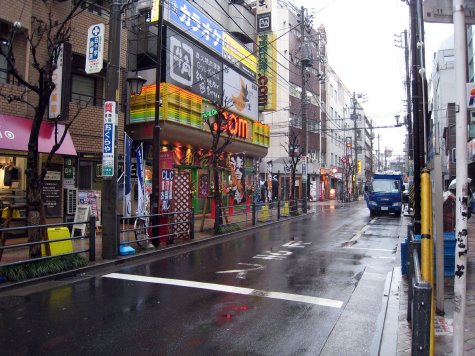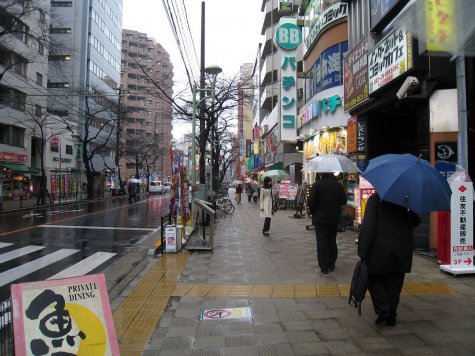The train platform is elevated, so we took the stairs down. Looking over my shoulder, there’s a gate with Japanese characters leading to the platform.
The streets aren’t rectilinear around Nippori. Walking out a little from the station and looking east, there’s a commercial area … but not textile stores.
Looking south, there were also storefronts, but the rag trade is a little farther on.
We headed south in the direction we thought correct. Apartment towers reveal the area to be mixed commercial and residential.
One of the first stores that we saw oriented towards apparel was Lemon, catering to children’s clothes.
Many stores were crowded with merchandise. This one had mannekins in a more spacious layout.
Despite the rain, the bins outside storefronts offered specials for the bargain hunters.
Perhaps the foot traffic wasn’t high in the late afternoon, so this shopkeeper had covered up his bins, and closed up for the day.
The Tomato store at Nippori seems to be well known.
A place to park umbrellas before entering a store demonstrates the Japanese attention to detail.
The variety of buttons available for purchase underscores that this neighbour is the central market for fabric and notions in Tokyo.
Looking at the wall of buttons, I wonder about the design of the cataloging system.
The nicer buttons are displayed in trays.
To encourage novices, some samples were framed and hung on the wall for display.
Marianne bought a handle for a bag that she was making, and showed it to Jennifer.
Keen shoppers could spend days wandering in and out of these stores.
This store had multiple floors of notions. Just hanging out on the ground floor was enough for Gary and me, while the ladies looked around the other levels.
I can’t think of why I would need this variety of decals or stickers.
After a few hours of shopping, Jennifer and Marianne decided to return to the hotel for a rest. Gary and I crossed over to the other side of the Nipport station. On the bridge over the track is a marker for Shimogoendenhashi.
As it typical in Tokyo, turning a corner often unexpectedly reveals a temple. Since we’ve seen a lot of them, we continued on.
The main shopping street for the neighbourhood is down the Yuyake Dandan stairs.
This isn’t a tourist neighbourhood. The Yanaka Ginza shops serve residents.
The local bakery was shielding some of its displays from the rain.
The neighbourhood fruit vendor is a contrast to the corporate-owned supermarkets in commercial districts.
In the busy Tokyo lifestyle, boxed meals could be picked up by residents on their way home.
The local fish store still had stock in the early evening.
If the shopper didn’t want prepare the fish, there’s always takeout sushi.
Continuing our walk, we exited out the another gate for the Yanaka Ginza district.
We wended our way past Nishi Nippori station, and up the hill.
The sun had set by the time we reached the entry to Nippori Park.
The park has fences for cats.
In the dark, we could barely make out the Koryo Inari Jinjin shrine.
The grounds around the Seiun-ji temple were accessible, but the temple itself was closed for the evening.
Returning down to the main street, we found the Darjeeling restaurant.
After a steady diet of Japanese food, a change to Indian cuisine was welcomed.
The Darjeeling bills itself as a tearoom, as much as a dining venue.
The rain continued even into the late evening, as Gary and I found our way back to our hotel.
[Start a large-image lightbox screen show over this blog post (in a supported browser)]







































